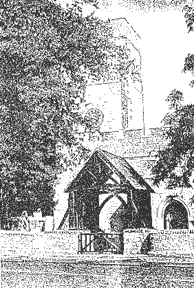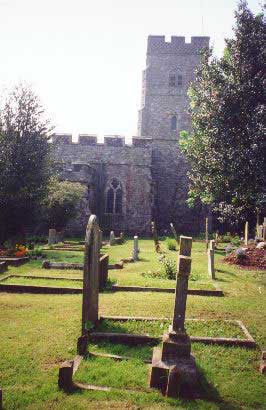

The Isle of Sheppey is a wonderful place. We had been in London and had long planned to motor down to Sheppey, winding thru the rural countryside and visit the village of Eastchurch where our ancestors had long ago been born, grew to adulthood, married, labored and passed away. The year 2000 was to be the year of that journey to find a part of our genealogical roots. The trip was so enjoyable and enlightening. We have promised ourselves to return to Eastchurch in the near future for more wandering and searching for our past. We shall do it!
The Isle of Sheppey is 9 miles long and 5 miles wide located east of London about 2 hours by car. The Isle is beautifully green with rolling fields of green and the yellow golden rape seed from which canola oil is produced. The fields when in bloom are fantastically sun-yellow and seem to spread thru the rolling hills for great distances.
Our areas of interest for the trip were the village of Eastchurch, Queenborough, and Sheerness.

This then is the photo-odyssey of our trip to the past-to find our ancestors and our link with them. Our thanks to to Mr. Malcolm Pordage, of Eastchurch, owner and operator of Dunmow House, a fine Bed and Breakfast located on Church Street in Eastchurch, a hearty thank you for his friendliness and hospitality. We hope to see you again in the near future when we return to Sheppey.

The original church once belonged to the Abbey of Our Lady of the Dunes at Koksijde on the Belgian Coast between Nieupoort and Dunkirk, which is now in ruins. It was in its time the most important Cistercian community in Flanders. An account of the release of King Richard I, 'The Lionheart', has been preserved in the chronicles of Dunes Abbey. According to these Elias, an Abbot of the Monestary from 1189 to 1203, played an important part in the efforts aimed at the release of the King, held prisoner by the Emperor of Germany. Thus the Abbey was granted the Church of Abbot's intercession. The charter granting this dates from April 1194, shortly after the King's return to England.
The wooden structure at the street entrance to the churchyard is a lychgate. Webster defines a lychgate as a roofed gate in a churchyard under which a bier rests during the initial part of the burial service. Our guide and friend Guy told us he had read that the lychgate was where a person was placed for approximately two days after they had died, to assure the family that the person was not unconscious or in a coma prior to burial.

By 1430, the original church at Eastchurch, like one other before it, was in ruins. The foundations had collapsed. William Cheyney, Lord Mayor of the Manor felt it his duty to take steps in the matter. In 1431, William Cheyney, fortified by a license from King Henry VI, assigned three roods of land on the Shurland estate to 'Our beloved in Christ the Abbot and Convent of the Church of Blessed Mary of Boxley' for the building of a new church for Eastchurch.

The Abbot decided that William Nudds, a Cistercian monk of Boxley, who was known to him as a man taking great interest in all buildings, should design a new church and act as architect during its construction and become the first vicar, which he did in 1432. And so the church was finished and consecrated on All Saints Day in 1432, with William Nudds as its first vicar.